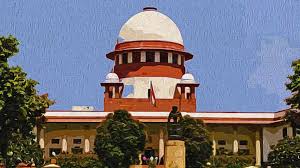Res Judicata. Issue decided collaterally or incidentally in earlier proceedings would not operate as res judicata. Supreme Court
- 28-January-2021 23:39
Nand Ram v. Jagdish Prasad, (2020) 9 SCC 393. Decided on 19 March 2020. Judgment Link: https://main.sci.gov.in/supremecourt/2011/4832/4832_2011_17_1502_21562_Judgement_19-Mar-2020.pdf
Relevant paragraphs 20. In a
judgment reported as Sajjadanashin Sayed Md. B.E. Edr. v. Musa Dadabhai Ummer
[Sajjadanashin Sayed Md. B.E. Edr. v. Musa Dadabhai Ummer, (2000) 3 SCC 350]
this Court held that if a matter was only “collaterally or incidentally” in
issue and decided in an earlier proceeding, the finding therein would not
ordinarily be res judicata in a latter proceeding where the matter is directly
and substantially in issue. This Court found that the statement of law
delineated by Mulla, 15th Edn., p. 104 is the correct one, that if the issue
was “necessary” to be decided for adjudicating on the principal issue and was
decided, it would have to be treated as “directly and substantially” in issue
and if it is clear that the judgment was in fact based upon that decision, then
it would be res judicata in a latter case. Such is the test for deciding into
which category a case falls. One has to examine the plaint, the written
statement, the issues and the judgment to find out if the matter was directly
and substantially in issue (Isher Singh v. Sarwan Singh [Isher Singh v. Sarwan
Singh, AIR 1965 SC 948] and Mohd. Salie Labbai v. Mohd. Hanifa [Mohd. Salie
Labbai v. Mohd. Hanifa, (1976) 4 SCC 780] ). Which matters are directly in
issue and which are only collaterally or incidentally in issue, must be
determined on the facts of each case. A material test to be applied is whether
the court considers the adjudication of the issue material and essential for
its decision.
23. The
issue in the proceedings under Section 30 of the Act, before the Reference
Court was restricted to the apportionment of compensation, consequent to the
acquisition of the leased land. The argument was raised that the lessee had
another 14 years of the lease period, therefore, the lessee claimed compensation
in lieu of the unexpired lease period. The issue was restricted to the payment
of compensation on account of the unexpired period of lease. The issue in
question was not the title of the appellants or the eviction of the respondent.
Still further, the finding of the Reference Court, as reproduced above (see
para 6, above), is that the respondent had no right to claim a share in the
compensation. The entitlement of the appellants to claim possession from the
tenant was not an issue in the previous proceedings.
24.
Before the award was announced by the Reference Court, part of the land
acquired was de-notified. After denotification of the land, the respondent
continued to be in possession and the title of the appellants as owners stood
restored. Denotification under Section 48 of the Act is possible only when
possession has not been taken and the land has not been vested in the State.
The effect of denotification is that the land comprising Khasra No. 9/19 was
never deemed to be acquired. Once the land was de-notified, the status of the
parties as they existed prior to notification under Section 4 of the Act stood
revived.
25. The
High Court has relied upon the findings recorded by the Reference Court that
the tenancy stood terminated so as to deny the apportionment of the
compensation in respect of acquisition of land. The issue examined by the
Reference Court was whether the defendant was entitled to any share of
compensation awarded for the land acquired. Such issue was decided against the
defendant. It is this finding that the defendant is not entitled to any share
of the compensation awarded which operates as res judicata in a subsequent suit
and not the reasonings recorded by the Court for arriving at such a finding. In
a judgment in Union of India v. Nanak Singh [Union of India v. Nanak Singh, AIR
1968 SC 1370] , it has been held that what operates as res judicata is the
decision and not the reasons given by the court in support of the decision.
26. In
another judgment in Mathura Prasad Bajoo Jaiswal v. Dossibai N.B. Jeejeebhoy
[Mathura Prasad Bajoo Jaiswal v. Dossibai N.B. Jeejeebhoy, (1970) 1 SCC 613] ,
a three-Judge Bench of this Court held that the previous decision on a matter
in issue alone is res judicata, the reasons for such decision are not res
judicata. This Court held as under: (SCC p. 617, para 5) “5. … A decision of a
competent court on a matter in issue may be res judicata in another proceeding
between the same parties: the “matter in issue” may be an issue of fact, an
issue of law, or one of mixed law and fact. An issue of fact or an issue of
mixed law and fact decided by a competent court is finally determined between
the parties and cannot be reopened between them in another proceeding. The
previous decision on a matter in issue alone is res judicata: the reasons for
the decision are not res judicata. A matter in issue between the parties is the
right claimed by one party and denied by the other, and the claim of right from
its very nature depends upon proof of facts and application of the relevant law
thereto. A pure question of law unrelated to facts which give rise to a right,
cannot be deemed to be a matter in issue. When it is said that a previous
decision is res judicata, it is meant that the right claimed has been
adjudicated upon and cannot again be placed in contest between the same
parties. A previous decision of a competent court on facts which are the
foundation of the right and the relevant law applicable to the determination of
the transaction which is the source of the right is res judicata. A previous
decision on a matter in issue is a composite decision: the decision on law
cannot be dissociated from the decision on facts on which the right is founded.
A decision on an issue of law will be as res judicata in a subsequent
proceeding between the same parties, if the cause of action of the subsequent
proceeding be the same as in the previous proceeding, but not when the cause of
action is different, nor when the law has since the earlier decision been
altered by a competent authority, nor when the decision relates to the
jurisdiction of the court to try the earlier proceeding, nor when the earlier
decision declares valid a transaction which is prohibited by law.”
27. Thus,
the finding returned in the award of the Reference Court (Ext. PW 1/12) that
the lease stood determined on account of non-payment of rent was a finding made
by the Reference Court for a limited purpose i.e. not to accept the defendant's
claim for compensation. Such finding cannot be binding on the parties in a suit
for possession based on title or as a lessor against a lessee. Section 11 of
the Code bars the subsequent court to try any suit or issue which has been
directly and substantially in issue in a former suit. The issue before the
Reference Court was apportionment of compensation and such issue having been
decided against the defendant, the reference to notice for termination of
tenancy does not operate as res judicata. Therefore, the finding recorded by
the High Court that the order of the Reference Court operates as res judicata
was clearly not sustainable. The first substantial question of law has been,
thus, wrongly decided.

